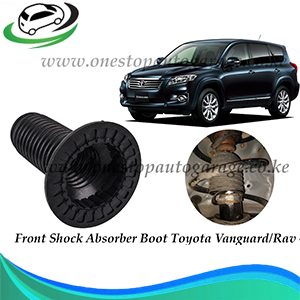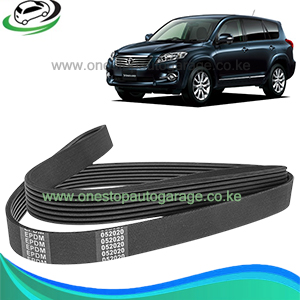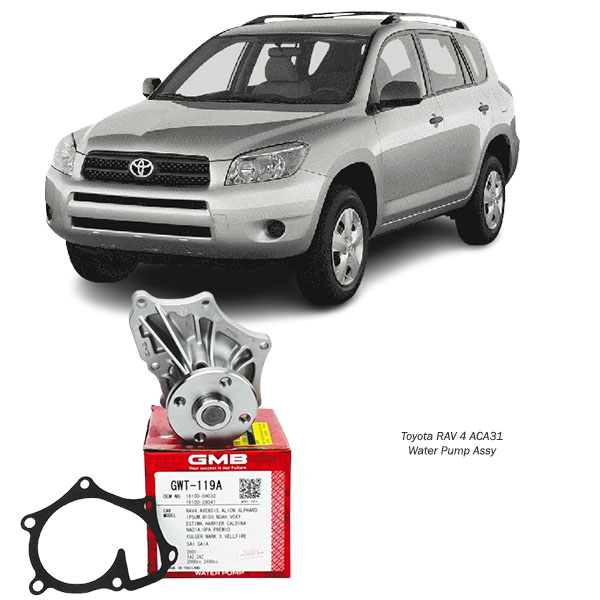-10%
Get Toyota RAV 4 ACA31 Water Pump Assy with 1AZ-FSE / 1AZ-FE / 2AZ-FE Engine GWT-119A in Kenya
The Water Pump Assembly is one of the most critical components in a vehicle’s cooling system. It ensures that coolant circulates through the engine, radiator, and heater core, preventing overheating and engine damage. Without a properly functioning water pump, your engine could overheat, leading to costly repairs or even a complete engine failure.
In this guide, we’ll cover everything about the water pump assembly, including its function, types, components, maintenance, common failures, replacement process, and benefits.
What is a Water Pump Assembly? 🤔💡
A water pump assembly is a mechanical device that pumps coolant through the engine’s cooling system. It is typically driven by a belt, chain, or electric motor, depending on the vehicle’s design.
Key Functions of the Water Pump Assembly:
✅ Circulates Coolant – Moves coolant from the radiator to the engine and back.
✅ Regulates Engine Temperature – Prevents overheating by keeping engine temperatures stable.
✅ Prevents Engine Damage – Avoids overheating-related issues like warped cylinder heads and gasket failures.
✅ Enhances Fuel Efficiency – A properly cooled engine operates more efficiently.
✅ Works with the Thermostat – Ensures proper coolant flow based on engine temperature.
Components of a Water Pump Assembly 🛠️🚗
A water pump assembly consists of several key components that work together to ensure smooth coolant circulation:
🔹 Pump Housing – The outer casing that holds all pump components.
🔹 Impeller – A rotating blade-like component that moves coolant through the system.
🔹 Shaft & Bearings – Support the impeller’s rotation and ensure smooth operation.
🔹 Pulley or Gear Drive – Connects the pump to the engine’s belt or timing system.
🔹 Seal & Gasket – Prevents coolant leaks around the pump.
🔹 Coolant Inlet & Outlet Ports – Direct the flow of coolant through the engine and radiator.
💡 Tip: If any of these components fail, the entire water pump assembly may need replacement.
Types of Water Pumps 🔧💦
Water pumps come in different designs based on the engine type and cooling system layout.
1️⃣ Mechanical Water Pump 🏎️
- Most common type found in older and modern combustion engines.
- Driven by the serpentine belt, timing belt, or timing chain.
- Works continuously while the engine runs.
2️⃣ Electric Water Pump ⚡
- Found in modern cars, hybrids, and electric vehicles (EVs).
- Powered by an electric motor, independent of the engine.
- More efficient, providing coolant flow only when needed.
3️⃣ Auxiliary Water Pump 🔄
- Used in turbocharged vehicles and hybrids.
- Assists the main water pump in cooling extra components.
- Commonly found in performance vehicles and EVs.
Signs of a Failing Water Pump 🚨🔧
A faulty water pump can cause serious engine problems. Here are the common symptoms to watch for:
🔹 Overheating Engine – If your temperature gauge reads high, the pump may be failing.
🔹 Coolant Leaks – Look for puddles of coolant (green, orange, or pink fluid) under your car.
🔹 Whining or Grinding Noise – Worn-out bearings can cause a squealing sound from the pump.
🔹 Steam from the Engine Bay – A sign of overheating due to insufficient coolant flow.
🔹 Low Coolant Levels – A leaking pump can cause frequent coolant loss.
🔹 Rust or Corrosion on the Pump – Indicates coolant contamination or old coolant.
💡 Tip: If you notice these signs, get your cooling system inspected immediately to avoid costly engine damage.
How to Replace a Water Pump Assembly 🔧🚗💦
Replacing a water pump requires mechanical knowledge and tools, but it’s doable as a DIY project for experienced car owners.
Tools Needed:
✅ New water pump assembly (check your car’s manual for specifications).
✅ Coolant (antifreeze) – Make sure to use the correct type for your vehicle.
✅ Socket wrench set & screwdrivers.
✅ Drain pan (to collect old coolant).
✅ Belt removal tool (if applicable).
Step-by-Step Replacement Guide 🛠️
1️⃣ Allow the Engine to Cool ❄️
- Never work on a hot engine! Wait until the engine is completely cool before starting.
2️⃣ Drain the Coolant 🚰
- Place a drain pan under the radiator and remove the radiator drain plug.
3️⃣ Remove the Drive Belt or Timing Cover 🔩
- If the water pump is belt-driven, remove the serpentine belt or timing cover.
4️⃣ Remove the Old Water Pump 🚮
- Unbolt the old pump and carefully remove it.
- Scrape off any old gasket material from the mounting surface.
5️⃣ Install the New Water Pump 🆕
- Place a new gasket or apply sealant before installing the pump.
- Tighten all bolts to the manufacturer’s recommended torque settings.
6️⃣ Refill with Coolant 🌊
- Use the correct type of coolant and fill the radiator and overflow tank.
7️⃣ Bleed the Cooling System 🔄
- Start the engine and let it run until the thermostat opens.
- Check for leaks and ensure smooth coolant circulation.
💡 Tip: Always replace the thermostat and coolant hoses when installing a new water pump for best performance.
Benefits of Regular Water Pump Maintenance ✅🚗
✔️ Prevents Engine Overheating – Ensures consistent coolant circulation.
✔️ Extends Engine Life – Reduces wear on cylinder heads, gaskets, and pistons.
✔️ Maintains Fuel Efficiency – Keeps the engine running at optimal temperature.
✔️ Prevents Costly Repairs – A failed pump can lead to blown head gaskets or engine failure.
✔️ Improves Heater Performance – Helps maintain consistent cabin heating in winter.
Water Pump vs. Thermostat: What’s the Difference? 🤔💡
Many people confuse the water pump with the thermostat. Here’s how they differ:
| Feature | Water Pump 🚗💦 | Thermostat 🌡️ |
|---|---|---|
| Function | Circulates coolant throughout the engine | Regulates coolant temperature |
| Location | Front of the engine, near the drive belt | Inside the coolant passageway |
| Failure Symptoms | Coolant leaks, overheating, noise | Stuck open (cold engine) or stuck closed (overheating) |
✅ Both components are critical for engine cooling!
Upgrading to a Performance Water Pump: Is It Worth It? 🚀
If you have a high-performance car, tow frequently, or live in a hot climate, consider upgrading to:
✅ High-Flow Water Pumps – Increase coolant circulation for better cooling.
✅ Electric Water Pumps – More efficient and adjustable coolant flow.
✅ Aluminum Pumps – Lighter and more resistant to corrosion than stock pumps.
While upgraded water pumps cost more, they improve engine cooling and longevity.
Conclusion 🎯
The Water Pump Assembly is an essential part of your car’s cooling system, preventing overheating and engine damage. Regular maintenance and timely replacement ensure smooth performance and a longer engine life.
💡 Key Takeaways:
✅ Replace the water pump every 60,000 – 100,000 miles (or per manufacturer guidelines).
✅ Watch for coolant leaks, overheating, and strange noises.
✅ Use quality coolant and check hoses regularly.
✅ Consider upgrading to a high-performance water pump if needed.
By keeping your water pump in top condition, you ensure a cooler, healthier, and more efficient engine!
Follow us on Facebook for more parts.



